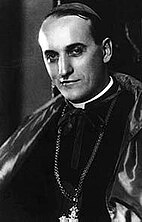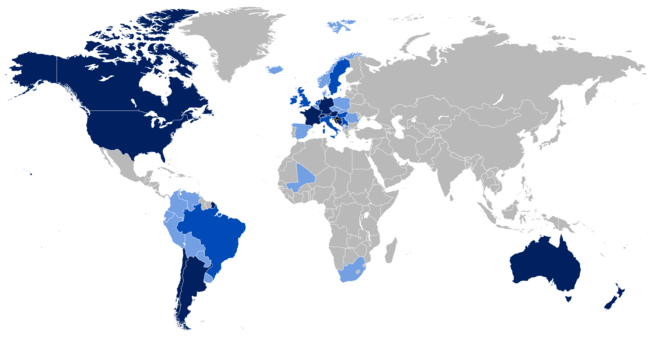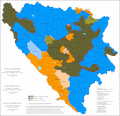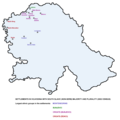Croats
Adriatic sea | |||||||||||||||||||||||||||||||||||||
| Total population | |||||||||||||||||||||||||||||||||||||
|---|---|---|---|---|---|---|---|---|---|---|---|---|---|---|---|---|---|---|---|---|---|---|---|---|---|---|---|---|---|---|---|---|---|---|---|---|---|
c. 7–8 million[1] | |||||||||||||||||||||||||||||||||||||
| Regions with significant populations | |||||||||||||||||||||||||||||||||||||
3,550,000 (2021)[2] 544,780 (2013)[3] | |||||||||||||||||||||||||||||||||||||
| 414,714 (2012)[4]–1,200,000 (est.)[5] | |||||||||||||||||||||||||||||||||||||
| 500,000 (2021)[6][7] | |||||||||||||||||||||||||||||||||||||
| 400,000[8] | |||||||||||||||||||||||||||||||||||||
| 250,000[9] | |||||||||||||||||||||||||||||||||||||
| 221,719 (2020)[10] | |||||||||||||||||||||||||||||||||||||
| 164,362 (2021)[11] | |||||||||||||||||||||||||||||||||||||
| 133,965 (2016)[12] | |||||||||||||||||||||||||||||||||||||
| 100,000[13] | |||||||||||||||||||||||||||||||||||||
| 80,000 (2021)[14] | |||||||||||||||||||||||||||||||||||||
| 70,000[9] | |||||||||||||||||||||||||||||||||||||
| 60,000[15] | |||||||||||||||||||||||||||||||||||||
| 50,000 (est.)[16] | |||||||||||||||||||||||||||||||||||||
| 41,502 (2023)[17] | |||||||||||||||||||||||||||||||||||||
| 40,000 (est.)[18] | |||||||||||||||||||||||||||||||||||||
| 39,107 (2022)[19] | |||||||||||||||||||||||||||||||||||||
| 35,000 (est.)[20] | |||||||||||||||||||||||||||||||||||||
| |||||||||||||||||||||||||||||||||||||
Catholicism[39] | |||||||||||||||||||||||||||||||||||||
| Related ethnic groups | |||||||||||||||||||||||||||||||||||||
| Other South Slavs[40] | |||||||||||||||||||||||||||||||||||||
a References:[41][42][43][44][45][46][47] | |||||||||||||||||||||||||||||||||||||
| Part of a series on |
| Croats |
|---|
 |
The Croats (.
Due to political, social and economic reasons, many Croats migrated to North and South America as well as New Zealand and later Australia, establishing a
Croats are mostly
Etymology
The foreign ethnonym variation "Croats" of the native name "Hrvati" derives from Medieval Latin Croāt, itself a derivation of North-West Slavic *Xərwate, by liquid metathesis from Common Slavic period *Xorvat, from proposed Proto-Slavic *Xъrvátъ which possibly comes from the 3rd-century Scytho-Sarmatian form attested in the Tanais Tablets as Χοροάθος (Khoroáthos, alternate forms comprise Khoróatos and Khoroúathos).[57] The origin of the ethnonym is uncertain, but most probably is from Proto-Ossetian / Alanian *xurvæt- or *xurvāt-, in the meaning of "one who guards" ("guardian, protector").[58]
History
Arrival of the Slavs
Early medieval archaeology
Archaeological evidence shows population continuity in coastal Dalmatia and Istria. In contrast, much of the Dinaric hinterland and appears to have been depopulated, as virtually all hilltop settlements, from Noricum to Dardania, were abandoned and few appear destroyed in the early 7th century. Although the dating of the earliest Slavic settlements was disputed, recent archaeological data established that the migration and settlement of the Slavs/Croats have been in late 6th and early 7th century.[60][61][62][63][64]
Croat ethnogenesis
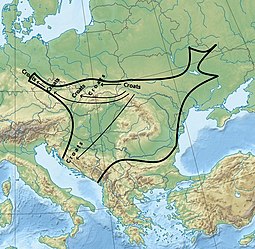
Much uncertainty revolves around the exact circumstances of their appearance given the scarcity of literary sources during the 7th and 8th century
Traditionally, scholarship has placed the arrival of the
Scholars have hypothesized the name Croat (Hrvat) may be Iranian, thus suggesting that the Croatians were possibly a Sarmatian tribe from the Pontic region who were part of a larger movement at the same time that the Slavs were moving toward the Adriatic. The major basis for this connection was the perceived similarity between Hrvat and inscriptions from the Tanais dated to the 2nd and 3rd centuries CE, mentioning the name Khoro(u)athos. Similar arguments have been made for an alleged Gothic-Croat link. Whilst there is possible evidence of population continuity between Gothic and Croatian times in parts of Dalmatia, the idea of a Gothic origin of Croats was more rooted in 20th century Ustaše political aspirations than historical reality.[68]
Other polities in Dalmatia and Pannonia

Other, distinct polities also existed near the Croat duchy. These included the
The Croats became the dominant local power in northern Dalmatia, absorbing Liburnia and expanding their name by conquest and prestige. In the south, while having periods of independence, the Naretines merged with Croats later under control of Croatian Kings.[85] With such expansion, Croatia became the dominant power and absorbed other polities between Frankish, Bulgarian and Byzantine empire. Although the Chronicle of the Priest of Duklja has been dismissed as an unreliable record, the mentioned "Red Croatia" suggests that Croatian clans and families might have settled as far south as Duklja/Zeta.[86]
Early medieval age
The lands which constitute modern Croatia fell under three major geographic-politic zones during the Middle Ages, which were influenced by powerful neighbor Empires – notably the Byzantines, the Avars and later
Pannonian Principality ("Savia")
This section needs additional citations for verification. (November 2015) |
Having been under Avar control, lower Pannonia became a march of the
For much of the subsequent period, Savia was probably directly ruled by the Carinthian
In 896, his rule stretched from Vienna and Budapest to the southern Croat duchies, and included almost the whole of ex-Roman Pannonian provinces. He probably died c. 900 fighting against his former allies, the Magyars.[87] The subsequent history of Savia again becomes murky, and historians are not sure who controlled Savia during much of the 10th century. However, it is likely that the ruler Tomislav, the first crowned King, was able to exert much control over Savia and adjacent areas during his reign. It is at this time that sources first refer to a "Pannonian Croatia", appearing in the 10th century Byzantine work De Administrando Imperio.[87]
Dalmatian Croats
The
The Croatian Prince
Facing a number of naval threats by
Branimir's (879–892) own actions were approved from the
Kingdom of Croatia (925–1102)

Tomislav was succeeded by
He was succeeded by
He was in conflict with dukes of
After his death civil war and unrest broke out shortly afterward as northern nobles decided Ladislaus I for the Croatian King. In 1093, southern nobles elected a new ruler, King
According to
Personal union with Hungary (1102–1918)
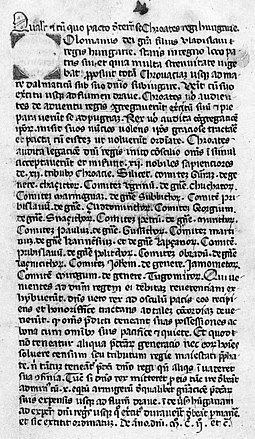
In the 11th and 12th centuries "the Croats were never unified under a strong central government. They lived in different areas - Pannonian Croatia, Dalmatian Croatia, Bosnia - which were at times ruled by indigenous kings but more frequently controlled by agents of Byzantium, Venice and Hungary. Even during periods of relatively strong centralized government, local lords frequently enjoyed an almost autonomous status".[112]
In the union with Hungary, institutions of separate Croatian statehood were maintained through the
In the second half of the 13th century, during the
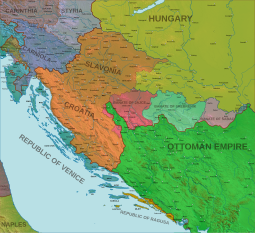
King Sigismund's army was catastrophically defeated at the

As the
The
Croats stopped the Ottoman advance in Croatia at the battle of Sisak in 1593, 100 years after the defeat at Krbava field, and the short Long Turkish War ended with the Peace of Zsitvatorok in 1606, after which Croatian classes tried unsuccessfully to have their territory on the Military Frontier restored to rule by the Croatian Ban, managing only to restore a small area of lost territory but failed to regain large parts of Croatian Kingdom (present-day western Bosnia and Herzegovina), as the present-day border between the two countries is a remnant of this outcome.[citation needed]
Croatian national revival (1593–1918)
In the first half of the 17th century, Croats fought in the Thirty Years' War on the side of Holy Roman Empire, mostly as light cavalry under command of imperial generalissimo Albrecht von Wallenstein. Croatian Ban, Juraj V Zrinski, also fought in the war, but died in a military camp near Bratislava, Slovakia, as he was poisoned by von Wallenstein after a verbal duel. His son, future ban and captain-general of Croatia, Nikola Zrinski, participated during the closing stages of the war.

In 1664, the Austrian imperial army was victorious against the Turks, but Emperor
Imperial spies uncovered the conspiracy and on 30 April 1671 executed four esteemed Croatian and Hungarian noblemen involved in it, including Zrinski and Frankopan in Wiener Neustadt. The large estates of two most powerful Croatian noble houses were confiscated and their families relocated, soon after extinguished. Between 1670 and the revolution of 1848, there would be only 2 bans of Croatian nationality. The period from 1670 to the Croatian cultural revival in the 19th century was Croatia's political Dark Age. Meanwhile, with the victories over Turks, Habsburgs all the more insistent they spent centralization and germanization, new regained lands in liberated Slavonia started giving to foreign families as feudal goods, at the expense of domestic element. Because of this the Croatian Sabor was losing its significance, and the nobility less attended it, yet went only to the one in Hungary.[citation needed]

In the 18th century, Croatia was one of the crown lands that supported Emperor

In the 19th century Croatian
By the 1840s, the movement had moved from cultural goals to resisting Hungarian political demands. By the royal order of 11 January 1843, originating from the chancellor Metternich, the use of the Illyrian name and insignia in public was forbidden.

This deterred the movement's progress but it couldn't stop the changes in the society that had already started. On 25 March 1848, was conducted a political petition "Zahtijevanja naroda", which program included thirty national, social and liberal principles, like Croatian national independence, annexation of Dalmatia and Military Frontier, independence from Hungary as far as finance, language, education, freedom of speech and writing, religion, nullification of serfdom etc. In the revolutions of 1848 in the Austrian Empire, the Croatian Ban Jelačić cooperated with the Austrians in quenching the Hungarian Revolution of 1848 by leading a military campaign into Hungary, successful until the Battle of Pákozd.[citation needed]
Croatia was later subject to Hungarian hegemony under ban Levin Rauch when the Empire was transformed into a dual monarchy of Austria-Hungary in 1867. Nevertheless, Ban Jelačić had succeeded in the abolition of serfdom in Croatia, which eventually brought about massive changes in society: the power of the major landowners was reduced and arable land became increasingly subdivided, to the extent of risking famine. Many Croatians began emigrating to the New World countries in this period, a trend that would continue over the next century, creating a large Croatian diaspora.
From 1804 to 1918, as many as 395 Croats received the rank of
Modern history (1918–present)
This section needs additional citations for verification. (November 2015) |
After the
In 1939, the Croats received a high degree of autonomy when the
Following the democratization of society, accompanied with ethnic tensions that emerged ten years after the death of Josip Broz Tito, the Republic of Croatia declared independence, which was followed by war. In the first years of the war, over 200,000 Croats were displaced from their homes as a result of the military actions. In the peak of the fighting, around 550,000 ethnic Croats were displaced altogether during the Yugoslav wars.[citation needed]
Post-war government's policy of easing the immigration of ethnic Croats from abroad encouraged a number of Croatian descendants to return to Croatia. The influx was increased by the arrival of Croatian refugees from Bosnia and Herzegovina. After the war's end in 1995, most Croatian refugees returned to their previous homes, while some (mostly Croat refugees from Bosnia and Herzegovina and Janjevci from Kosovo) moved into the formerly-held Serbian housing.[citation needed]
Genetics
Language


Croats primarily speak
Besides Shtokavian, Croats from the Adriatic coastline speak the
The beginning of written Croatian can be traced to the 9th century, when
The most important early monument of Croatian literacy is the Baška tablet from the late 11th century.[141] It is a large stone tablet found in the small Church of St. Lucy, Jurandvor on the Croatian island of Krk which contains text written mostly in Chakavian, today a dialect of Croatian, and in Shtokavian angular Glagolitic script. It mentions Zvonimir, the king of Croatia at the time. However, the luxurious and ornate representative texts of Croatian Church Slavonic belong to the later era, when they coexisted with the Croatian vernacular literature. The most notable are the "Missal of Duke Novak" from the Lika region in northwestern Croatia (1368), "Evangel from Reims" (1395, named after the town of its final destination), Hrvoje's Missal from Bosnia and Split in Dalmatia (1404).[142] and the first printed book in Croatian, the Glagolitic Missale Romanum Glagolitice (1483).[139]
During the 13th century Croatian vernacular texts began to appear, the most important among them being the "Istrian Land Survey" of 1275 and the "
The
Bunjevac dialect
The Bunjevac dialect (bunjevački dijalekt)[146][147][148] or Bunjevac speech (bunjevački govor)[149] is a Neo-ShtokavianYounger Ikavian dialect of the Serbo-Croatian pluricentric language, used by members of the Bunjevac community. It is an integral part of the cultural heritage of the Bunjevac Croats in northern Serbia (Vojvodina) and parts of southern Hungary. Their accent is purely Ikavian, with /i/ for the Common Slavic vowels yat.[150] Its speakers largely use the Latin alphabet.
Croatia introduced in 2021 the categorisation of
There have been three meritorious people who preserved the Bunjevac dialect in two separate dictionaries: Grgo Bačlija[154] and Marko Peić[155] with "Ričnik bački Bunjevaca"[156] (editions 1990, 2018), and Ante Sekulić[157] with "Rječnik govora bačkih Hrvata" (2005).
Popularly, the Bunjevac dialect is often referred to as "Bunjevac language" or Bunjevac
The
Religion
This section needs additional citations for verification. (September 2018) |
Croats are predominantly Catholic, and before Christianity, they adhered to
The beginnings of the Christianization are also disputed in the historical texts: the Byzantine texts talk of Duke Porin who started this at the incentive of emperor Heraclius (610–641), then of Duke Porga who mainly Christianized his people after the influence of missionaries from Rome. However, it can be realiably said that the Christianisation of Croats began in the 7th century, initially probably encompassed only the elite and related people,[162] but mostly finished by the 9th century.[163][164] The earliest known Croatian autographs from the 8th century are found in the Latin Gospel of Cividale.[citation needed]
Croats were never obliged to use Latin—rather, they held
Smaller groups of Croats adhere to other religions, like
Culture
Tradition

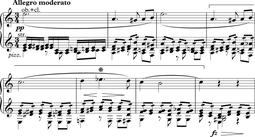
The area settled by Croats has a large diversity of historical and cultural influences, as well as the diversity of terrain and geography. The coastland areas of Dalmatia and
UNESCO | Intangible Cultural Heritage of Humanity in Croatia
- "Bećarac singing and playing from Eastern Croatia";
- "Festivity of Saint Blaise, the patron of Dubrovnik";
- "Gingerbread craft from Northern Croatia";[169]
- "Klapa multipart singing of Dalmatia, southern Croatia";
- "Lacemaking in Croatia";
- "Međimurska popevka, a folksong from Međimurje";
- "Nijemo Kolo, silent circle dance of the Dalmatian hinterland";
- "Procession Za Križen('following the cross')";
- "Spring procession of Ljelje/Kraljice (queens) from Gorjani";[170]
- "Traditional manufacturing of children's wooden toys of Hrvatsko Zagorje";
- "Two-part singing and playing in the Istrian scale";
- "Zvončari, annual carnival bell ringers' pageant from the Kastav area."[171][172]
Arts

Architecture in Croatia reflects the influences of bordering nations. Austrian and Hungarian influence is visible in public spaces and buildings in the north and in the central regions, architecture found along the coasts of Dalmatia and Istria exhibits Venetian influence.
Besides the architecture encompassing the oldest artworks in Croatia, there is a long history of artists in Croatia reaching to the Middle Ages. In that period the stone portal of the Trogir Cathedral was made by Radovan, representing the most important monument of Romanesque sculpture in Croatia. The Renaissance had the greatest impact on the Adriatic Sea coast since the remainder of Croatia was embroiled in the Hundred Years' Croatian–Ottoman War. With the waning of the Ottoman Empire, art flourished during the Baroque and Rococo. The 19th and the 20th centuries brought about the affirmation of numerous Croatian artisans, helped by several patrons of the arts such as bishop Josip Juraj Strossmayer.[178] Croatian artists of the period achieving worldwide renown were Vlaho Bukovac and Ivan Meštrović.[176]
The
Symbols

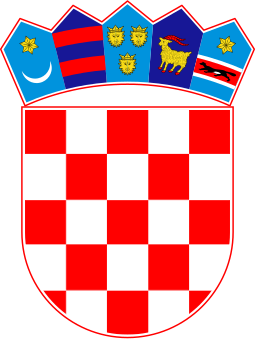
The
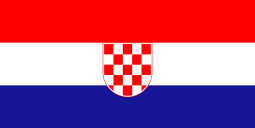
The
Unlike in many countries, Croatian design more commonly uses symbolism from the coat of arms, rather than from the Croatian flag. This is partly due to the geometric design of the shield which makes it appropriate for use in many graphic contexts (e.g. the insignia of
Communities
In Croatia (the
The subgroups of Croats are commonly based on
(Kosovo).Autochthonous communities
- Croatia is the nation-stateof Croats.
- In Bosnia and Herzegovina, Croats are one of three constitute ethnic groups, numbering around 544,780 people or 15.43% of the population. The entity of Federation of Bosnia and Herzegovina is home to the majority (495,000 or about little under 90%) of Bosnian and Herzegovinian Croats.
- In Montenegro, the Bay of Kotor, Croats are a national minority, numbering 6,021 people or 0.97% of the population.
- In Serbia, Croats are a national minority, numbering 57,900 people or 0.80% of the population. They mostly live in the region of Vojvodina, where Croatian is official (along with five other languages), and the national capital city of Belgrade.
- In Slovenia, Croats are not recognized as a minority, numbering 35,642 people or 1.81% of the population. They mostly live in Slovene Littoral, Prekmurje and in the Metlika area in Lower Carniola regions.
Croatian communities with minority status
- In Austria, Croats are an ethnic minority, numbering around 30,000 people in Burgenland (Burgenland Croats), the eastern part of Austria,[182] and around 15,000 people in the capital city of Vienna.
- In the Czech Republic, Croats are a national minority, numbering 850–2,000 people, forming a portion of the 29% minority (as "Others"). They mostly live in the region of Moravia, in the villages of Jevišovka, Dobré Pole and Nový Přerov.
- In Hungary, Croats are an ethnic minority, numbering 25,730 people or 0.26% of the population.[183]
- In Italy, linguistic, and ethnic minority, numbering 23,880 people, of which 2,801 people belong to the ethnic minority of Molise Croats from the region of Molise.
- In Romania, Croats are a national minority, numbering 6,786 people. They mostly live in the Caraș-Severin County, in communes of Lupac (90.7%) and Carașova(78.28%).
- In Serbia, Croats (including Bunjevci and Šokci) are a national minority. They mostly live in the multiethnic autonomous province of Vojvodina.
- In Slovakia, Croats are an ethnic and national minority, numbering around 850 people. They mostly live in the area around Bratislava, in the villages of Chorvátsky Grob, Čunovo, Devínska Nová Ves, Rusovce and Jarovce.
Other regions with Croat minorities
- In Bulgaria, there exists a small Croatian community, a branch of Janjevci, Croats from Kosovo.
- In New Zealand, the mixed Croatian and Māori Tarara people have their own culture, traditions and customs, and live in Te Tai Tokerau, New Zealand's northernmost region. 15 March is Tarara Dayto celebrate their heritage.
- In Kosovo, Croats or Janjevci (Letničani), as they inhabited mostly the town of Janjevo, before 1991 numbered 8,062 people, but after the war many fled, and as of 2011[update] number only 270 people.
- In North Macedonia, Croats number 2,686 people or 0.1% of the population, mostly living in the capital city of Skopje, the city of Bitola and around the Lake Ohrid.
Diaspora
This section needs additional citations for verification. (September 2018) |
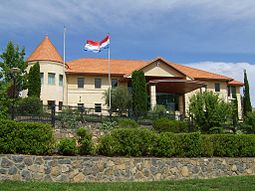
There are currently 4–4.5 million Croats in diaspora throughout the world. The Croat diaspora was the consequence of either mostly economic or political (coercion or expulsions) reasons:
- To other European countries (Austria, Slovakia, Germany, Hungary), caused by the conquering of Ottoman Turks, when Croats as Catholicswere oppressed.
- To the Americas (largely to Colombia, and Ecuador) in the end of 19th and early 20th century, large numbers of Croats emigrated particularly for economic reasons.
- To New Zealand, predominately the Northland Region, to work on Kauri gum plantations.[13]
- A further, larger wave of emigration, this time for political reasons, took place after the end of the World War II in Yugoslavia. At this time, both collaborators of the Ustasha regime and those who did not want to live under a communist regime fled the country, to the Americas and Oceania once more.
- As immigrant workers, particularly to Germany, Austria, and emigrants left for political reasons. This migration made it possible for communist Yugoslaviato achieve lower unemployment and at the same time the money sent home by emigrants to their families provided an enormous source of foreign exchange income.
- The last large wave of Croat emigration occurred during and after the Yugoslav Wars (1991–1995). Migrant communities already established in the Americas, Oceania, and across Europe grew as a result.
The count for diaspora is approximate because of incomplete statistical records and naturalization. Overseas, the United States contains the largest Croatian emigrant group (414,714 according to the 2010 census), mostly in Ohio, Pennsylvania, Illinois and California, with a sizable community in Alaska, followed by Australia (133,268 according to the 2016 census, with concentrations in Sydney, Melbourne and Perth) and Canada (133,965 according to the 2016 census, mainly in Southern Ontario, British Columbia and Alberta).
Various estimations put the total number of Americans and Canadians with at least some Croatian ancestry at 2 million, many of whom do not identify as such in the countries' censuses.[41][42][43][44][45][184][47][185]
Croats have also emigrated in several waves to South America: chiefly Chile, Argentina, and Brazil; estimates of their number vary wildly, from 150,000 up to 500,000.[186][187] Both the presidents of Chile (Gabriel Boric) and Argentina (Javier Milei) are of Croatian descent.[188][189]
There are also smaller groups of Croatian descendants in Brazil, Ecuador, Peru, South Africa, Mexico, and South Korea. The most important organizations of the Croatian diaspora are the Croatian Fraternal Union, Croatian Heritage Foundation and the Croatian World Congress.
Maps
-
Croats in Croatia
-
Croats in Bosnia and Herzegovina in 2013
-
Croats in Vojvodina, Serbia
-
Croats in Romania
Historiography
See also
- Croatia, nation-state of Croats
- Demographics of Croatia
- Timeline of Croatian history
- List of Croats
- List of rulers of Croatia
- Genetic studies on Croats
- Origin hypotheses of the Croats
- Medieval Slav tribes; South Slavs
References
- ISBN 978-0-71906-502-6. Archivedfrom the original on 27 September 2023. Retrieved 12 July 2020.
- ^ "Central Bureau of Statistics". Dzs.hr. Archived from the original on 17 May 2019. Retrieved 26 March 2013.
- ^ Sarajevo, juni 2016. Cenzus of Population, Households and Dwellings in Bosnia and Herzegovina, 2013 Final Results (PDF). BHAS. Archived from the original (PDF) on 24 December 2017. Retrieved 30 June 2016.
- ^ Results American Fact Finder (US Census Bureau)
- ^ Croatian diaspora in the USA Archived 7 May 2021 at the Wayback Machine. "It has been estimated that around 1,200,000 Croats and their descendants live in the USA."
- ^ German Federal Statistical Office Archived 5 July 2006 at the Wayback Machine
- ^ "State Office for Croats Abroad". Hrvatiizvanrh.hr. Archived from the original on 30 September 2018. Retrieved 18 March 2015.
- ^ Diaspora Croata Archived 9 May 2016 at the Wayback Machine El Ministerio de Relaciones Exteriores de la República de Chile evalúa que en ese país actualmente viven 380.000 personas consideradas de ser de descendencia croata, lo que es un 2,4% de la población total de Chile.
- ^ a b c d "Status of Croatian immigrants and their descendants abroad". Republic of Croatia: State Office for Croats Abroad. Archived from the original on 13 February 2019. Retrieved 20 July 2013.
- ^ Census 2001 [dead link] "Tabelle 5: Bevölkerung nach Umgangssprache und Staatsangehörigkeit", page 60 "131,307 Croatians + 19,412 Burgenland Croats = 150,719. In the Austrian census, Burgenland Croats are separate from the main Croat group."
- ^ "Cultural diversity: Census Information on country of birth, year of arrival, ancestry, language and religion". Australian Bureau of Statistics. 9 October 2022. Archived from the original on 2 July 2023. Retrieved 7 October 2022.
- ^ "Immigration and Ethnocultural Diversity Highlight Tables". statcan.gc.ca. 25 October 2017. Archived from the original on 27 October 2017. Retrieved 28 September 2018.
- ^ a b "Carter: NZ Celebrates 150 Years of Kiwi-Croatian Culture". voxy.co.nz. Archived from the original on 31 December 2019. Retrieved 29 November 2022.
- ^ "2006 Figures Publ.Document.88215.pdf" (PDF). p. 68. Archived from the original (PDF) on 24 June 2008. Note: Petra-P12, gives a 40,484 number. as of 2004 Archived 11 January 2012 at the Wayback Machine page 12 2.1.1. Ständige ausländische Wohnbevölkerung nach Nationalität 2001–04, gives a 44,035 number.
- ^ "Croatian diaspora in Italy". Središnji državni ured za Hrvate izvan Republike Hrvatske. Archived from the original on 5 July 2020. Retrieved 25 January 2020.
- ^ "Statistini urad RS – Popis 2002". Archived from the original on 6 August 2011. Retrieved 18 March 2015.
- ^ "Situación actual y proyecciones del desarrollo futuro de la población de origen croata en Paraguay" (PDF). imin.hr. January 2023. Archived (PDF) from the original on 3 February 2023. Retrieved 30 April 2023.
- Ministry of Foreign Affairs and International Development. Archivedfrom the original on 30 June 2016. Retrieved 28 June 2016.
- ^ "Попис становништва, домаћинстава и станова 2011. у Републици Србији" (PDF). Webrzs.stat.gov.rs. Archived from the original (PDF) on 8 July 2018. Retrieved 12 December 2017.
- ^ "Hrvatsko iseljeništvo u Švedskoj". Hrvatiizvanrh.hr (in Croatian). Archived from the original on 20 February 2019. Retrieved 18 March 2015.
- ISBN 978-963-235-542-9. Archived (PDF) from the original on 8 August 2019. Retrieved 9 January 2019.)
{{cite book}}:|work=ignored (help)CS1 maint: location missing publisher (link - ^ "Census of Population 2022 - Summary Results: Migration and Diversity". cso.ie. 30 May 2023. Retrieved 31 December 2023.
- ^ "State Office for Croats Abroad". Hrvatiizvanrh.hr. Archived from the original on 20 February 2019. Retrieved 18 March 2015.
- ^ "Veza s Hrvatima izvan Hrvatske". Archived from the original on 4 March 2007. Retrieved 18 March 2015.
- ^ "Dom i svijet – Broj 227 – Croatia klub u Juznoj Africi". Archived from the original on 28 March 2017. Retrieved 18 March 2015.
- ^ "OECD dataset". Archived from the original on 4 May 2011. Retrieved 20 September 2008.
- ^ Census in Romania Archived 13 May 2007 at the Wayback Machine
- ^ Montenegrin census[dead link] page 14 Population by national or ethnic affiliation – Review for Republic of Montenegro and municipalities
- ^ "República de Croacia". Cancillería. 26 September 2013. Archived from the original on 22 December 2014. Retrieved 20 February 2015.
- ^ Joshua Project. "Country – Denmark: Joshua Project". Archived from the original on 2 November 2013. Retrieved 18 March 2015.
- ^ "Population by immigrant category and country background". Statistics Norway. 1 January 2015. Archived from the original on 15 July 2018. Retrieved 18 March 2015.
- ^ "State Office for Croats Abroad". Hrvatiizvanrh.hr. Archived from the original on 1 February 2019. Retrieved 18 March 2015.
- ^ "SODB2021 – Obyvatelia – Základné výsledky". scitanie.sk. Archived from the original on 31 May 2022. Retrieved 25 August 2022.
- ^ "SODB2021 – Obyvatelia – Základné výsledky". scitanie.sk. Archived from the original on 15 July 2022. Retrieved 25 August 2022.
- ^ "From the lives of Croatian faithful outside Croatia". Archived from the original on 27 October 2005.
- ^ "Croats of Czech Republic: Ethnic People Profile". czso.cz. Czech Statistical Office. Archived from the original on 9 March 2021. Retrieved 17 April 2017.
- ^ "Sefstat" (PDF). Archived (PDF) from the original on 20 March 2022. Retrieved 13 February 2022.
- ^ Всероссийская перепись населения 2010. Национальный состав населения Archived 6 September 2018 at the Wayback Machine (in Russian)
- ISBN 0-87451-815-6.
[...] the three ethnoreligious groups that have played the roles of the protagonists in the bloody tragedy that has unfolded in the former Yugoslavia: the Christian Orthodox Serbs, the Catholic Croats, and the Muslim Slavs of Bosnia.
- ^ "Ethnologue – South Slavic languages". ethnologue.com. Archived from the original on 25 December 2018. Retrieved 8 February 2011.
- ^ a b Farkas, Evelyn (2003). Fractured States and U.S. Foreign Policy. Iraq, Ethiopia, and Bosnia in the 1990s. Palgrave Macmillan US. p. 99.
- ^ a b Paquin, Jonathan (2010). A Stability-Seeking Power: US Foreign Policy and Secessionist Conflicts. McGill-Queen's University Press. p. 68.
- ^ a b Directory of Historical Organizations in the United States and Canada. American Association for State and Local History. 2002. p. 205.
- ^ a b Zanger, Mark (2001). The American Ethnic Cookbook for Students. Greenwood. p. 80.
- ^ a b Levinson, Ember, David, Melvin (1997). American immigrant cultures: builders of a nation. Macmillan. p. 191.
{{cite book}}: CS1 maint: multiple names: authors list (link) - ^ Foreign Operations, Export Financing, and Related Programs Appropriations for 1994: Testimony of members of Congress and other interested individuals and organizations. United States. Congress. House. Committee on Appropriations. Subcommittee on Foreign Operations, Export Financing, and Related Programs. 1993. p. 690.
- ^ a b National Genealogical Inquirer. Janlen Enterprises. 1979. p. 47.
- ^ "Croat". Lexico UK English Dictionary. Oxford University Press. Archived from the original on 2 December 2020.
- ISBN 978-0-306-48321-9, archivedfrom the original on 27 September 2023, retrieved 29 October 2015,
It is estimated that 4.5 million Croatians live outside Croatia (...)
- ^ "About Us – Croatian World Coungress". 15 October 2007. Archived from the original on 15 October 2007. Retrieved 12 December 2017.
- ^ a b Влада Аутономне Покрајине Војводине Archived 29 November 2014 at the Wayback Machine
- ^ a b "Republicki Zavod za Statistiku – Republike Srbije". Archived from the original on 22 April 2009.
- ^ "Croatian :: Ngati Tarara 'The Olive and Kauri'". croatianclub.org. Archived from the original on 29 November 2022. Retrieved 29 November 2022.
- ^ Kapiteli, Marija; Taonga, New Zealand Ministry for Culture and Heritage Te Manatu. "Tarara Day". teara.govt.nz. Archived from the original on 29 November 2022. Retrieved 29 November 2022.
- ^ "European Commission – Frequently asked questions on languages in Europe". europa.eu. Archived from the original on 16 December 2020. Retrieved 6 August 2019.
- ^ "About BiH". Bhas.ba. Agency for Statistics of Bosnia and Herzegovina. Archived from the original on 11 July 2012. Retrieved 7 August 2019.
- ISBN 953-162-000-8.
- ^ Matasović, Ranko (2019), "Ime Hrvata" [The Name of Croats], Jezik (Croatian Philological Society) (in Croatian), 66 (3), Zagreb: 81–97, archived from the original on 12 December 2022, retrieved 4 April 2023
- ^ Fine 1991, pp. 26–41.
- from the original on 26 March 2023. Retrieved 3 July 2022.
- ISBN 978-83-63760-10-6.
- ISBN 978-953-6803-36-1.
- ISBN 978-953-8082-01-6.
- from the original on 12 December 2022. Retrieved 3 July 2022.
- ^ Dzino (2010, p. 175)
- ^ Borri (2011, p. 215)
- ^ Curta (2006, p. 138)
- ^ Dzino (2010, p. 20)
- ISBN 9782503526157. Archivedfrom the original on 10 August 2023. Retrieved 13 July 2022.
- ^ Dzino (2010, p. 186)
- ^ Wolfram (2002) Liudewit is considered the first Croatian prince. Constantine Porphyrogenitus has Dalmatia and parts of Slavonia populated by Croatians. But this author wrote more than a hundred years after the Frankish Royal annals which never mention the name of the Croatians although a great many Slavic tribal names are mentioned in the text. Therefore, if one applies the methods of an ethnogenetic interpretation, the Croatian Liudewit seems to be an anachronism.
- ^ Dvornik, F.; Jenkins, R. J. H.; Lewis, B.; Moravcsik, Gy.; Obolensky, D.; Runciman, S. (1962). P. J. H. Jenkins (ed.). De Administrando Imperio: Volume II. Commentary. University of London: The Athlone Press. pp. 139, 142. Archived from the original on 27 September 2023. Retrieved 13 July 2022.
- ^ Curta 2006, p. 210.
- ISBN 953-169-032-4. Archived from the original(PDF) on 4 May 2019. Retrieved 13 July 2022.
- ^ Gračanin, Hrvoje (2008), "Od Hrvata pak koji su stigli u Dalmaciju odvojio se jedan dio i zavladao Ilirikom i Panonijom: Razmatranja uz DAI c. 30, 75-78", Povijest U Nastavi (in Croatian), VI (11): 67–76, archived from the original on 19 December 2022, retrieved 13 July 2022
- ^ Budak (2018, pp. 51, 111, 177, 181–182)
- ISBN 86-17-13754-1.
- ^ Živković, Tibor (2012). "Неретљани – пример разматрања идентитета у раном средњем веку" [Arentani – an Example of Identity Examination in the Early Middle Ages]. Istorijski časopis. 61: 12–13.
- ^ Dvornik 1962, p. 139, 142.
- ^ Fine 1991, p. 37, 57.
- ISBN 978-0-19-974163-2.
- ^ Dvornik 1962, p. 138–139:Even if we reject Gruber's theory, supported by Manojlović (ibid., XLIX), that Zachlumje actually became a part of Croatia, it should be emphasized that the Zachlumians had a closer bond of interest with the Croats than with the Serbs, since they seem to have migrated to their new home not, as C. says (33/8-9), with the Serbs, but with the Croats; see below, on 33/18-19 ... This emendation throws new light on the origin of the Zachlumian dynasty and of the Zachlumi themselves. C.'s informant derived what he says about the country of Michael's ancestors from a native source, probably from a member of the prince's family; and the information is reliable. If this is so, we must regard the dynasty of Zachlumje and at any rate part of its people as neither Croat nor Serb. It seems more probable that Michael's ancestor, together with his tribe, joined the Croats when they moved south; and settled on the Adriatic coast and the Narenta, leaving the Croats to push on into Dalmatia proper. It is true that our text says that the Zachlumi 'have been Serbs since the time of that prince who claimed the protection of the emperor Heraclius' (33/9-10); but it does not say that Michael's family were Serbs, only that they 'came from the unbaptized who dwell on the river Visla, and are called (reading Litziki) "Poles'". Michael's own hostility to Serbia (cf. 32/86-90) suggests that his family was in fact not Serb; and that the Serbs had direct control only over Trebinje (see on 32/30). C.'s general claim that the Zachlumians were Serbs is, therefore, inaccurate; and indeed his later statements that the Terbouniotes (34/4—5), and even the Narentans (36/5-7), were Serbs and came with the Serbs, seem to conflict with what he has said earlier (32/18-20) on the Serb migration, which reached the new Serbia from the direction of Belgrade. He probably saw that in his time all these tribes were in the Serb sphere of influence, and therefore called them Serbs, thus ante-dating by three centuries the state of affairs in his own day. But in fact, as has been shown in the case of the Zachlumians, these tribes were not properly speaking Serbs, and seem to have migrated not with the Serbs but with the Croats. The Serbs at an early date succeeded in extending their sovereignty over the Terbouniotes and, under prince Peter, for a short time over the Narentans (see on 32/67). The Diocleans, whom C. does not claim as Serbs, were too near to the Byzantine thema of Dyrrhachion for the Serbs to attempt their subjugation before C.'s time
- ISBN 9780813506135. Archivedfrom the original on 27 September 2023. Retrieved 21 July 2022.
Constantine regards all Slavic tribes in ancient Praevalis and Epirus—the Zachlumians, Tribunians, Diodetians, Narentans— as Serbs. This is not exact. Even these tribes were liberated from the Avars by the Croats who lived among them. Only later, thanks to the expansion of the Serbs, did they recognize their supremacy and come to be called Serbians.
- ^ Živković 2006, pp. 60–61:Constantine Porphyrogenitus explicitly calls the inhabitants of Zahumlje Serbs who have settled there since the time of Emperor Heraclius, but we cannot be certain that the Travunians, Zachlumians and Narentines in the migration period to the Balkans really were Serbs or Croats or Slavic tribes which in alliance with Serbs or Croats arrived in the Balkans
- ^ "Neretljani". Hrvatski obiteljski leksikon (in Croatian). Archived from the original on 13 December 2017. Retrieved 12 December 2017.
- ^ Fine (2005, p. 6203)
- ^ a b c d Wolfram (2002)
- ^ Fine 1991, p. 257.
- ^ Fine 1991, p. 261.
- ^ Hrvatski leksikon (1996–1997) (in Croatian)[full citation needed]
- ^ Stjepan Antoljak, Pregled hrvatske povijesti, Split 1993., str. 43.
- ^ "Kralj Tomislav". Hrvatski vojnik (in Croatian). 30 November 2018. Archived from the original on 27 September 2020. Retrieved 27 May 2020.
- ISBN 978-0-86054-685-6. Archivedfrom the original on 27 September 2023. Retrieved 2 October 2020.
- ^ Bonifačić, Antun; Mihanovich, Clement Simon (1955). The Croatian nation in its struggle for freedom and independence: a symposium. "Croatia" Cultural Pub. Center. Archived from the original on 27 September 2023. Retrieved 2 October 2020.
- ^ De Administrando Imperio, Byzantine Emperor Constantine VII Porphyrogenitos, 950
- ^ Vedriš, Trpimir (2007). "Povodom novog tumačenja vijesti Konstantina VII. Porfirogeneta o snazi hrvatske vojske" [On the occasion of the new interpretation of Constantine VII Porphyrogenitus'report concerning the strength of the Croatian army]. Historijski zbornik (in Croatian). 60: 1–33. Archived from the original on 22 October 2021. Retrieved 29 July 2020.
- ^ Budak 2018, pp. 223–224.
- ^ Bakalov, Istorija na Bǎlgarija, "Simeon I Veliki"
- ISBN 978-0-8059-2893-8. Archivedfrom the original on 27 September 2023. Retrieved 29 April 2012.
- ^ Royal Anthropological Institute of Great Britain and Ireland; JSTOR (Organization) (1882). Journal of the Royal Anthropological Institute of Great Britain and Ireland. The Institute. Retrieved 29 April 2012.
- Miroslav Krleža Lexicographical Institute, 2021, archivedfrom the original on 28 September 2023, retrieved 10 October 2023
- Miroslav Krleža Lexicographical Institute, 2021, archivedfrom the original on 6 August 2023, retrieved 10 October 2023
- ^ (in Croatian) PETAR KREŠIMIR IV.TRPIMIROVIĆ
- Miroslav Krleža Lexicographical Institute, 2021, archivedfrom the original on 5 November 2022, retrieved 10 October 2023
- ^ Budak 2018, pp. 229, 252.
- ^ Dominik Mandić, Rasprave i prilozi iz stare hrvatske povijesti, Institute of Croatian history, Rome, 1963., page 315., 438.
- ^ "18. Slavac – Dmitar Zvonimir" (PDF). 13 March 2012. Archived from the original (PDF) on 13 March 2012. Retrieved 12 December 2017.
- ^ "Demetrius, Duke of Croatia and Dalmatia". Archived from the original on 12 February 2006.
- ISBN 978-953-0-30703-2.
- Miroslav Krleža Lexicographical Institute, 2021, archivedfrom the original on 28 September 2023, retrieved 10 October 2023
- from the original on 4 July 2016. Retrieved 10 October 2023.
- ^ ISBN 978-0-521-41411-1.
- ^ "Croatia". Encyclopædia Britannica. Archived from the original on 18 March 2015. Retrieved 18 March 2015.
- ^ Curta, Stephenson, p. 267
- ^ "Full text of "The southern Slav question and the Habsburg Monarchy"". Archive.org. Retrieved 18 March 2015.
- ISBN 978-0-521-78505-1. Archivedfrom the original on 27 September 2023. Retrieved 2 October 2020.
- ^ Catholic Encyclopedia
- ^ a b Lipovac, Marijan (6 February 2024). "Vojna povijest Hrvata – Od 1804. do 1918. godine čak 395 osoba s područja Hrvatske dobilo je generalski ili admiralski čin, od čega 379 u vojsci Habsburške Monarhije, odnosno Austro-Ugarske". hrvatska-povijest.hr (in Croatian).
- ^ "Vlada Autonomne Pokrajine Vojvodine – Index". Vojvodina.gov.rs. Archived from the original on 12 February 2012. Retrieved 17 February 2012.
- S2CID 18011987.
- PMID 35722696.
- S2CID 34621779.
However, a study by Battaglia et al. (2009) showed a variance peak for I2a1 in the Ukraine and, based on the observed pattern of variation, it could be suggested that at least part of the I2a1 haplogroup could have arrived in the Balkans and Slovenia with the Slavic migrations from a homeland in present-day Ukraine. The calculated age of this specific haplogroup together with the variation peak detected in the suggested Slavic homeland could represent a signal of Slavic migration arising from medieval Slavic expansions. However, the strong genetic barrier around the area of Bosnia and Herzegovina, associated with the high frequency of the I2a1b-M423 haplogroup, could also be a consequence of a Paleolithic genetic signal of a Balkan refuge area, followed by mixing with a medieval Slavic signal from modern-day Ukraine.
- PMID 24667786,
R1a-M458 exceeds 20% in the Czech Republic, Slovakia, Poland, and Western Belarus. The lineage averages 11–15% across Russia and Ukraine and occurs at 7% or less elsewhere (Figure 2d). Unlike hg R1a-M458, the R1a-M558 clade is also common in the Volga-Uralic populations. R1a-M558 occurs at 10–33% in parts of Russia, exceeds 26% in Poland and Western Belarus, and varies between 10 and 23% in the Ukraine, whereas it drops 10-fold lower in Western Europe. In general, both R1a-M458 and R1a-M558 occur at low but informative frequencies in Balkan populations with known Slavonic heritage.
- ^ O.M. Utevska (2017). Генофонд українців за різними системами генетичних маркерів: походження і місце на європейському генетичному просторі [The gene pool of Ukrainians revealed by different systems of genetic markers: the origin and statement in Europe] (PhD) (in Ukrainian). National Research Center for Radiation Medicine of National Academy of Sciences of Ukraine. pp. 219–226, 302. Archived from the original on 17 July 2020. Retrieved 17 July 2020.
- ISBN 978-963-263-855-3. Archivedfrom the original on 27 September 2023. Retrieved 12 December 2020.
Az I2-CTS10228 (köznevén "dinári-kárpáti") alcsoport legkorábbi közös őse 2200 évvel ezelőttre tehető, így esetében nem arról van szó, hogy a mezolit népesség Kelet-Európában ilyen mértékben fennmaradt volna, hanem arról, hogy egy, a mezolit csoportoktól származó szűk család az európai vaskorban sikeresen integrálódott egy olyan társadalomba, amely hamarosan erőteljes demográfiai expanzióba kezdett. Ez is mutatja, hogy nem feltétlenül népek, mintsem családok sikerével, nemzetségek elterjedésével is számolnunk kell, és ezt a jelenlegi etnikai identitással összefüggésbe hozni lehetetlen. A csoport elterjedése alapján valószínűsíthető, hogy a szláv népek migrációjában vett részt, így válva az R1a-t követően a második legdominánsabb csoporttá a mai Kelet-Európában. Nyugat-Európából viszont teljes mértékben hiányzik, kivéve a kora középkorban szláv nyelvet beszélő keletnémet területeket.
- ,
Based on SNP analysis, the CTS10228 group is 2200 ± 300 years old. The group's demographic expansion may have begun in Southeast Poland around that time, as carriers of the oldest subgroup are found there today. The group cannot solely be tied to the Slavs, because the proto-Slavic period was later, around 300–500 CE... The SNP-based age of the Eastern European CTS10228 branch is 2200 ± 300 years old. The carriers of the most ancient subgroup live in Southeast Poland, and it is likely that the rapid demographic expansion which brought the marker to other regions in Europe began there. The largest demographic explosion occurred in the Balkans, where the subgroup is dominant in 50.5% of Croatians, 30.1% of Serbs, 31.4% of Montenegrins, and in about 20% of Albanians and Greeks. As a result, this subgroup is often called Dinaric. It is interesting that while it is dominant among modern Balkan peoples, this subgroup has not been present yet during the Roman period, as it is almost absent in Italy as well (see Online Resource 5; ESM_5).
- ^ PMID 38065079.
- ^ Cvjetan et al. 2004.
- PMID 23667324.
- PMID 26332464.
- , retrieved 10 December 2020
- ^ David Dalby, Linguasphere (1999/2000, Linguasphere Observatory), pg. 445, 53-AAA-g, "Srpski+Hrvatski, Serbo-Croatian".
- ^ Benjamin W. Fortson IV, Indo-European Language and Culture: An Introduction, 2nd ed. (2010, Blackwell), pg. 431, "Because of their mutual intelligibility, Serbian, Croatian, and Bosnian are usually thought of as constituting one language called Serbo-Croatian."
- ^ Václav Blažek, "On the Internal Classification of Indo-European Languages: Survey" Archived 4 February 2012 at the Wayback Machine, phil.muni.cz; retrieved 20 October 2010, pp. 15–16.
- ISBN 978-953-6316-76-2.
- ISBN 978-953-160-052-1.
- ^ Journal of Croatian studies (1986) 27–30:45
- ^ "Croatia: Themes, Authors, Books | Yale University Library Slavic and East European Collection". Library.yale.edu. 16 November 2009. Archived from the original on 29 October 2013. Retrieved 27 October 2010.
- ^ ISBN 978-0-631-19286-2.
- ^ Kapetanović, Amir (2005). "HRVATSKA SREDNJOVJEKOVNA LATINICA". Hrvatska Srednjovjekovna Latinica. Archived from the original on 6 February 2020. Retrieved 1 January 2013.
- ^ Branko Fučić (September 1971). "Najstariji hrvatski glagoljski natpisi". Slovo (in Croatian). 21. Old Church Slavonic Institute. Archived from the original on 3 July 2016. Retrieved 1 January 2013.
- ^ "Hrvoje's Missal ~ 1403–1404". Archived from the original on 1 March 2021. Retrieved 9 March 2012.
- ^ "VINODOLSKI ZAKON (1288)". Archived from the original on 29 April 2007. Retrieved 9 March 2012.
- ^ "Istarski Razvod". Archived from the original on 29 April 2007. Retrieved 9 March 2012.
- ^ "Vatikanski hrvatski molitvenik". Archived from the original on 11 October 2017. Retrieved 9 March 2012.
- ^ Aleksandar Raič and Suzana Kujundžić Ostojić (2014). Bunjevci izmed asimilacije i nacionalne zajednice. p. 144. Archived from the original on 1 December 2022. Retrieved 25 January 2022.
Bunjevački jezik u javnoj upotribi. Dakle, za onaj jezik za koji mi kažemo jezik, a zvanično je priznat ko dijalekat.
- ^ Hrvatska katolička mreža (20 March 2021). "Ne postoji bunjevački jezik, nego bunjevački govor". Archived from the original on 4 April 2022. Retrieved 9 April 2022.
From the scientific and linguistic point of view, we can say that it is a traditional Croatian language. Numerous records speak of this, all Croatian linguists, all world Slavic linguists, and even leading Serbian linguists have never questioned the Croatian origin of the Bunjevac dialect. Željko Jozić
- ^ Josip Lisac (9 April 2021). "Novoštokavski ikavski najveći je hrvatski dijalekt". Hrvatska Riječ. Archived from the original on 25 January 2022. Retrieved 25 January 2022.
- ^ "Grgo Bačlija: Bunjevački je govor, a ne jezik". Hrvatska Riječ (in Croatian). 8 March 2021. Archived from the original on 31 July 2021.
- ^ "Masumi Kameda. Language Ideologies of the Bunjevac Minority in Vojvodina: Historical Backgrounds and the Post-1991 Situation" (PDF). 2014. pp. 95–119. Archived (PDF) from the original on 16 December 2021. Retrieved 26 November 2021.
- ^ "Bunjevački govori". Archived from the original on 21 June 2022. Retrieved 7 August 2022.
Bunjevački govori pripadaju novoštokavskom ikavskom dijalektu štokavskoga narječja hrvatskoga jezika.
- ^ "Bunjevački govori". Archived from the original on 21 June 2022. Retrieved 8 April 2023.
Razlikuju se tri ogranka Bunjevačkih govora – podunavski, primorsko-lički i dalmatinski, a svi su kulturno bliski prema povijesnim, etnološkim i lingvističkim istraživanjima.
- ^ "Одлука о утврђивању стандарда буњевачког језика: 18/2018-192". 2018. Archived from the original on 2 September 2021. Retrieved 2 April 2022.
DECISION."Official Gazette of RS", No. 18 of March 9, 2018. The standard of the Bunjevac language is determined:- the established standard must be applied in textbooks and teaching of the Bunjevac language / speech;- the established standard must be applied in the media registered in order to achieve the public interest of information in the Bunjevac language;- The National Council of the Bunjevac National Minority may support in co-financing only those publications in the Bunjevac language that are in accordance with the established standard of the Bunjevac language;
- ^ "In memoriam: Grgo Bačlija (1939. – 2021.)". Hrvatska Riječ. 02-12-2021. p. Hitovi:74. Archived from the original on 2 December 2021. Retrieved 3 December 2021.
- ^ "Masumi Kameda. Language Ideologies of the Bunjevac Minority in Vojvodina: Historical Backgrounds and the Post-1991 Situation" (PDF). 2014. p. 113 (95–119). Archived (PDF) from the original on 16 December 2021. Retrieved 26 November 2021.
- ^ "REČNIK BAČKIH BUNJEVACA". Archived from the original on 12 November 2021. Retrieved 12 November 2021.
- ^ "Sombor: Predstavljen "Rječnik govora bačkih Hrvata" akademika dr. Ante Sekulića/". February 2008. Archived from the original on 12 November 2021. Retrieved 12 November 2021.
- ^ "предлагач: градско веће – SUBOTICA.com. 21 April 2021" (PDF). p. 26. Archived (PDF) from the original on 4 April 2022. Retrieved 13 March 2022.
Od 2007. godine u škole se uvodi izborni predmet Bunjevački govor sa elementima nacionalne kulture, a predmet nakon standardizacije jezika menja svoj naziv u Bunjevački jezik sa elementima nacionalne kulture.
- ^ "Osnovne škole u AP Vojvodini". Provincial Secretariat for Education, Regulations, Administration and National Minorities – National Communities. Archived from the original on 4 April 2022. Retrieved 13 March 2022.
U osnovnim školama na teritoriji AP Vojvodine, pored nastave na srpskom jeziku, nastava se ostvaruje i na još pet jezika (mađarski, slovački, rumunski, rusinski i hrvatski). Pored redovne nastave na navedenim jezicima, učenicima je omogućeno i izučavanje mađarskog, slovačkog, rumunskog, rusinskog i hrvatskog jezika, kao i još šest jezika (ukrajinski, bunjevački, romski, bugarski, makedonski i češki), što je ukupno jedanaest jezika u okviru izborne nastave – Maternji jezik / govor sa elementima nacionalne kulture. 11.05.2021
- ^ Institut za hrvatski jezik i jezikoslovlje. "Prijedlog za proglašenje bunjevačkoga govora nematerijalnom kulturnom baštinom". Archived from the original on 6 March 2022. Retrieved 3 March 2022.
Institut za hrvatski jezik i jezikoslovlje uputio je Ministarstvu kulture RH prijedlog da se bunjevački govor proglasi hrvatskom nematerijalnom kulturnom baštinom, kao važan čin pomoći bunjevačkomu govoru i svim Bunjevcima u Hrvatskoj i inozemstvu.
- ^ Fajin Deran, Ministry of Culture and Media of the Republic of Croatia (8 October 2021). "Bunjevački govori upisani u Registar kulturnih dobara Republike Hrvatske kao nematerijalno kulturno dobro". Archived from the original on 9 January 2023. Retrieved 26 July 2022.
- ^ Budak 2018, pp. 144–145.
- ISSN 0352-3101.
- ^ Živković, Tibor (2013a). "On the Baptism of the Serbs and Croats in the Time of Basil I (867–886)" (PDF). Studia Slavica et Balcanica Petropolitana (1): 33–53.
- ^ "The right to use the Glagolitic language at Mass with the Roman Rite has prevailed for many centuries in all the south-western Balkan countries, and has been sanctioned by long practice and by many popes" (Dalmatia Archived 3 March 2016 at the Wayback Machine in Catholic Encyclopedia)
- ^ Marko Japundzić. The Croatian Glagolitic Heritage Archived 10 August 2007 at the Wayback Machine, croatianhistory.net; accessed 25 November 2015.
- ^ "4. Population by ethnicity and religion". Census of Population, Households and Dwellings 2011. Zagreb: Croatian Bureau of Statistics. December 2012. Retrieved 17 December 2012.
- ISBN 978-0-19-816647-4.
- ^ "Gingerbread craft from Northern Croatia". Archived from the original on 10 December 2020. Retrieved 19 November 2021.
- ^ "Spring procession of Ljelje/Kraljice". Archived from the original on 10 December 2020. Retrieved 16 November 2021.
- ^ "Zvončari, annual carnival bell ringers' pageant from the Kastav area". Archived from the original on 8 December 2020. Retrieved 19 November 2021.
- ^ "Intangible Cultural Heritage UNESCO-Croatia". Archived from the original on 17 November 2021. Retrieved 16 November 2021.
- ISBN 978-0-521-09531-0. Archivedfrom the original on 27 September 2023. Retrieved 30 November 2011.
- ^ "Najljepši gradovi Sjeverne Hrvatske – Karlovac, Ozalj, Ogulin" [The Most Beautiful Cities of the Northern Croatia – Karlovac, Ozalj, Ogulin]. Jutarnji list (in Croatian). 14 August 2010. Archived from the original on 4 May 2016. Retrieved 10 October 2011.
- ISSN 0350-3437. Archived from the original(PDF) on 21 July 2011. Retrieved 10 October 2011.
- ^ a b "CROATIAN ART HISTORY – OVERVIEW OF PREHISTORY". Ministry of Foreign Affairs and European Integration (Croatia). Archived from the original on 7 October 2011. Retrieved 10 October 2011.
- ^ "Church of Saint Donat". Zadar Tourist Board. Archived from the original on 24 March 2014. Retrieved 10 October 2011.
- from the original on 13 December 2019. Retrieved 10 October 2011.
- ^ "The Baška tablet". Island of Krk Tourist Board. Archived from the original on 2 May 2019. Retrieved 13 October 2011.
- Miroslav Krleža Lexicographical Institute. 11 February 2011. Archived from the originalon 17 December 2011. Retrieved 13 October 2011.
- ^ Robert D. Kaplan (18 April 1993). "A Reader's Guide to the Balkans". The New York Times. Archived from the original on 9 December 2008. Retrieved 15 February 2017.
- ^ "HKDC Geschichte – Frame". Croates.at. Archived from the original on 22 April 2008. Retrieved 21 November 2008.
- ^ Hungarian Central Statistical Office Population by national/ethnic groups Archived 14 April 2011 at the Wayback Machine
- ^ Foreign Operations, Export Financing, and Related Programs Appropriations for 1994: Testimony of members of Congress and other interested individuals and organizations. United States. Congress. House. Committee on Appropriations. Subcommittee on Foreign Operations, Export Financing, and Related Programs. 1993. p. 690.
- ^ "HIA – iseljenici". Hia.com.hr. Archived from the original on 4 March 2007. Retrieved 18 March 2015.
- ^ Većeslav Holjevac. "In his book Hrvati izvan domovine estimates the number of Croatian emigrants in South America at 180,000 in 1932". Croatian Heritage Foundation. Archived from the original on 11 March 2007.
- ^ "The Croatian Emigrant Adresary places the total number of Croats in South America as high as 500,000". Croatian Emigrant Adresary. Archived from the original on 4 March 2007.
- ^ "Chilean Politician of Croatian Origin Runs for Presidency". Balkan Insight. 5 November 2021. Archived from the original on 31 May 2022. Retrieved 19 December 2021.
- ^ "Rodrigo Lussich reveló qué lazo familiar lo une a Javier Milei y sorprendió a todos". La Nación (in Spanish). 22 November 2023. Retrieved 3 December 2023.
Sources
- ISBN 978-953-340-061-7. Archivedfrom the original on 3 October 2022. Retrieved 10 August 2020.
- Dzino, Danijel (2010), Becoming Slav, Becoming Croat. Identity transformations in post-Roman and Early Medieval Dalmatia, Brill
- ISBN 9781139428880. Archivedfrom the original on 27 September 2023. Retrieved 2 August 2017.
- ISBN 9780521815390.
- Curta, Florin (2010), "The early Slavs in the northern and eastern Adriatic region. A critical approach", Archeologia Medievale, 37
- Fine, John Van Antwerp (1991). The early medieval Balkans: a critical survey from the sixth to the late twelfth century. University of Michigan Press. ISBN 978-0-472-08149-3. Archivedfrom the original on 27 September 2023. Retrieved 2 October 2020.
- ISBN 0472025600. Archivedfrom the original on 27 September 2023. Retrieved 20 December 2022.
- Wolfram, Herwig (2002), "Slavic Princes in the Carolingian Marches of Bavaria", Hortus Artium Medievalium, 8: 205–208,
- I. H. Garipzanov; P. Geary; P. Urbanczyk, eds. (2008), "Identities in Early Medieval Dalmatia (Seventh–Eleventh Centuries)", Franks, Northmen, and Slavs Identities and State Formation in Early Medieval Europe, Brepols
- Borri, Francesco (2011), "White Croatia and the arrival of the Croats: an interpretation of Constantine Porphyrogenitus on the oldest Dalmatian history", Early Medieval Europe, 19 (2): 204–231, S2CID 163100298
- L. Barać; et al. (2003). "Y chromosomal heritage of Croatian population and its island isolates" (PDF). (PDF) from the original on 17 December 2012. Retrieved 28 June 2013.
- S. Rootsi; et al. (2004). "Phylogeography of Y-Chromosome Haplogroup I Reveals Distinct Domains of Prehistoric Gene Flow in Europe" (PDF). American Journal of Human Genetics. 75 (1): 128–137. (PDF) from the original on 5 September 2020. Retrieved 10 November 2018.
- M. Peričić; et al. (2005). "High-resolution phylogenetic analysis of southeastern Europe traces major episodes of paternal gene flow among Slavic populations". PMID 15944443.
- V. Battaglia; et al. (2008). "Y-chromosomal evidence of the cultural diffusion of agriculture in southeast Europe". European Journal of Human Genetics. 17 (6): 820–830. PMID 19107149.
- S. Cvjetan; et al. (2004). "Frequencies of mtDNA Haplogroups in Southeastern Europe-Croatians, Bosnians and Herzegovinians, Serbians, Macedonians and Macedonian Romani". Collegium Antropologicum. 28 (1): 193–198. PMID 15636075.
- Heršak, Emil; Nikšić, Boris (2007), "Hrvatska etnogeneza: pregled komponentnih etapa i interpretacija (s naglaskom na euroazijske/nomadske sadržaje)" [Croatian Ethnogenesis: A Review of Component Stages and Interpretations (with Emphasis on Eurasian/Nomadic Elements)], Migration and Ethnic Themes (in Croatian), 23 (3), archived from the original on 8 August 2014, retrieved 10 November 2018
External links
![]() Media related to Croats at Wikimedia Commons
Media related to Croats at Wikimedia Commons
- (in Croatian) Matica hrvatska
- Review of Croatian History at Central and Eastern European Online Library
- "Croats of Bosnia and Herzegovina: History". Archived from the original on 15 June 2002.
- The Croatian nation at the beginning of the 20th century
- Famous Croats and Croatian cultural heritage
- Croatians in Arizona


